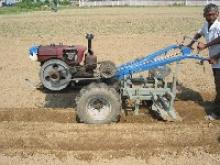Labour-saving technologies and practices: single axle tractors
The following describes the features of single-axle tractors. Their advantages and disadvantages are also explained.
Description
1. Features
- Single axle tractors are commonly used in Asia but not in Africa, partly due to harsher conditions and less irrigated land in the latter.
- They range in power from around 1.5 kW to 15 kW, controlled by the operator walking behind them.
- The draught force they exert is low as it is dependent on the weight on the driving wheels and is usually less than the draught force from a good team of oxen.
- Their engine power is most effectively used through a rotovator.
- The most suitable environment for using rotovators is under wetland or irrigated agriculture, where the soil moisture content can be controlled to suit the use of rotovators.
- It is also where there is usually an adequate quantity of organic matter to incorporate into the soil to increase soil aggregation.
- Otherwise, rotovators tend to pulverize the soil, particularly under dry soil conditions, destroying soil aggregates and leaving a high proportion of individual soil particles.
- This worsens soil structure and leads to a reduced water infiltration rate, higher erosion potential and compaction problems.
- The most suitable environment for using rotovators is under wetland or irrigated agriculture, where the soil moisture content can be controlled to suit the use of rotovators.
- Work rates for shallow secondary tillage, such as weeding, are similar to draught animals.
2. Advantages
- Labour-saving
- Less drudgery and labour-saving.
- Reasonably high work rates for tasks such as inter-row weeding.
- They can be used for multiple tasks from land preparation to post harvest.
- Livelihood resilience strengthening
- Allows for expansion of cultivated area, improved quality of operations and improved timeliness.
- Good quality work for seedbed preparation if used under correct moisture conditions.
- Small size makes them suitable for use on small plot holdings.
- The improvement of field conditions helps to improve income and food security, thus making livelihoods more resilient.
- Livelihood diversification
- Opportunity to earn income through hire services and other activities (irrigation pumping, transport, etc.).
3. Disadvantages
- Livelihood
- Potential damage to pulverize soil, particularly when used under dry soil conditions.
- Equipment
- Relatively complex, usually imported.
- Cost
- High ownership costs compared to draught animals and hence high risks for owner.
- Skills
- Farmers require training in operation and maintenance.
- Risk
- Risk if viability is dependent on contractual services, but farmers lack cash to pay for such services.
- Infrastructure
- Considerable established infrastructure support is required for their efficient operation although less than that required for four wheeled tractors.
Figure 1. Single axle tractors with bed planter

©FAO/TECA
4. Agro-ecological zones
- Tropics, warm.
5. Related/associated technologies
- Animal traction and single-axle tractor drawn planters in conservation agriculture: ID 7416.
- Draught animal power technologies in East Africa: ID 4535.
- Development of tools for draught animals: ID 4483.
- Labour-saving technologies and practices: draught animal power and implements: ID 7306.
- Improving the productivity of draught animal power in sub-Saharan Africa: ID 4467.
- Labour-saving technologies and practices: draught animal powered and motorised crop processing: ID 7307.
6. Objectives fulfilled by the project
6.1 Labour saving technology (LST)
The practice reduces manpower through using motorized tractors.
6.2 Pro-poor technology
The practice improves productivity and allows expansion of cultivated area, improved quality of operations, and improved timeliness.
المؤلف: Rural Infrastructure and Agro-industries Division (Agricultural Machinery and Infrastructure) AGS in FAO
المنظمة: The Food and Agriculture Organization of the United Nations FAO TECA
السنة: 2020
النوع: الممارسات
النص الكامل متاح على: https://www.fao.org/teca/en/technologies/7315
لغة المحتوى: English
